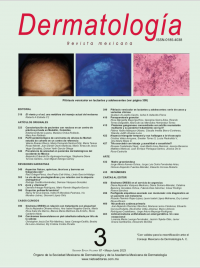Temporal triangular alopecia and associated trichoscopic findings.
Dermatol Rev Mex. 2023; 67 (3): 422-426. https://doi.org/10.24245/drm/bmu.v67i3.8860
Cristina Vélez-Arroyave, Sneider Torres S, Lucía Piedrahíta V, Ana María Mejía G
Servicio de Dermatología, Hospital General de Medellín Luz Castro de Gutiérrez, Universidad CES, Medellín, Colombia.
Resumen
ANTECEDENTES: La alopecia temporal triangular es un tipo de alopecia no cicatricial que inicia en la infancia y persiste en la adultez. Se manifiesta como un parche alopécico no cicatricial y recibe su nombre por su localización típica en el área frontotemporal. Puede tener forma ovalada o de un triángulo de ángulos romos. Existen pocos reportes de caso de este tipo de alopecia y poco conocimiento sobre ella, por lo que puede confundirse con otros tipos de alopecia, especialmente en la edad adulta. Tiene hallazgos tricoscópicos específicos descritos como aperturas foliculares normales, vellos, anisotricosis y pelos blancos, que son útiles para diferenciarla de otros trastornos más comunes como la alopecia areata. Generalmente las características clínicas y tricoscópicas son suficientes para establecer el diagnóstico y no se requiere toma de biopsia. El tratamiento va dirigido hacia mejorar la apariencia estética y pocas terapias tópicas han mostrado ser efectivas.
CASOS CLÍNICOS: Comunicamos dos casos de alopecia temporal triangular, uno en un recién nacido y otro en un adulto joven, en ambos casos el uso de la tricoscopia fue muy útil para establecer su diagnóstico y descartar otros diferenciales.
CONCLUSIONES: La importancia de estos casos radica en considerar a la alopecia temporal triangular parte del enfoque de las alopecias no cicatriciales, pues un diagnóstico equivocado podría llevar a costos innecesarios para el paciente y debe explicarse desde el inicio el carácter resistente y permanente de esta enfermedad.
PALABRAS CLAVE: Alopecia; subdiagnosticada; pelos blancos.
Abstract
BACKGROUND: Temporal triangular alopecia is a type of non-scarring alopecia that begins in childhood and persists into adulthood. It is a benign condition that causes alopecia and does not progress over time. It presents as a non-scarring alopecic patch and receives its name from its typical location in the frontotemporal area. It can be oval in shape or appear as a triangle with blunt angles. There are few case reports of this type of alopecia, which is why it can be misdiagnosed with other types of alopecia, it occurs especially in adulthood. Temporal triangular alopecia has specific trichoscopic findings, such as normal follicular openings, villi, anisotrichosis, and white hairs. Trichoscopy is a useful tool to differentiate it from other more common disorders such as alopecia areata. Generally, the clinical and trichoscopic characteristics are sufficient to establish the diagnosis and biopsy is not required. Treatment is directed toward improving cosmetic appearance, and few topical therapies have been shown to be effective.
CLINICAL CASES: This paper reports two cases of temporal triangular alopecia, one in a newborn and the other in a young adult. In both cases, the use of trichoscopy was very useful to make the diagnosis and rule out other differentials.
CONCLUSIONS: The importance of these cases lies in considering temporal triangular alopecia part of the approach to non-scarring alopecia, since a wrong diagnosis could lead to unnecessary costs. And it is important to explain the patients the resistant and permanent course of this disease.
KEYWORDS: Alopecia; Misdiagnosed; White hairs.
Recibido: abril 2022
Aceptado: junio 2022
Este artículo debe citarse como: Vélez-Arroyave C, Torres SS, Piedrahíta VL, Mejía GAM. Alopecia triangular temporal y sus hallazgos a la tricoscopia. Dermatol Rev Mex 2023; 67 (3): 422-426.

